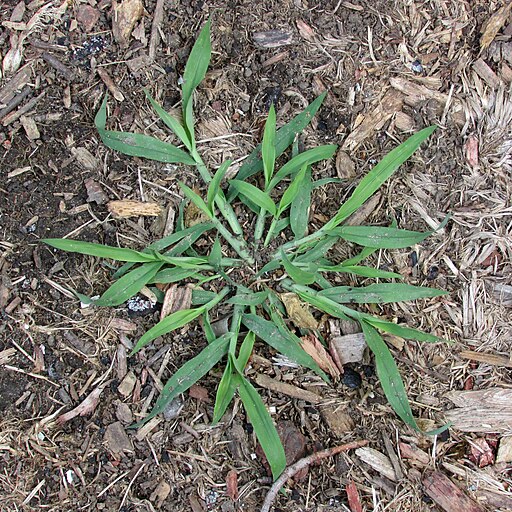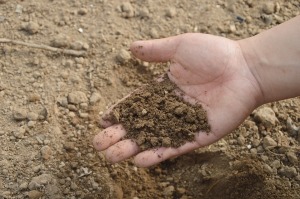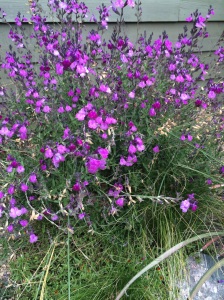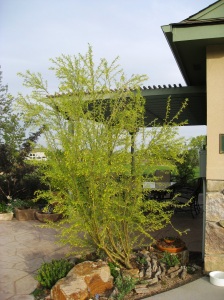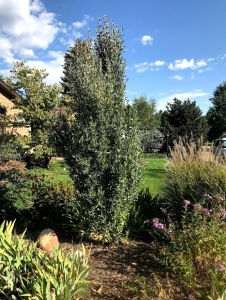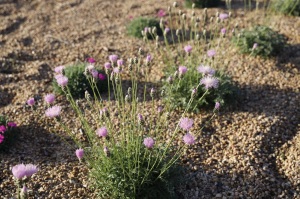Help Beautify Our Gardens
We’re seeking gardening volunteers starting Tuesday, April 2!
No experience is necessary; any amount of time you can spare is greatly appreciated. We provide training and orientation, so don’t worry if you’re new to gardening. We believe everyone has unique gifts to share, and we’d love for you to be part of our team. Join us in nurturing our green spaces and fostering community growth!
Make new friends, have fun, breathe fresh air, and contribute to the growth of horticulture in the Pikes Peak region. HAS runs on volunteer power and you as a helper can learn much about gardening from local gardeners.
Tuesday or Thursday Volunteers-Starting in April, join the HAS Gardener and
volunteers on Tuesdays or Thursdays, 9:00 – 12:00 to help in the Demonstration garden.
Work may include planting, weeding, raking, and other activities.
“Wednesday Volunteers”- Starting in April, join the HAS Gardener and others on
Wednesday mornings from 9:00 – 12:00, to help in the Heritage Garden. Work may
include planting, weeding, raking, and other activities. In case of wet or cold weather,
volunteering may be canceled.
If you would like to get outdoors, sign up to volunteer here.
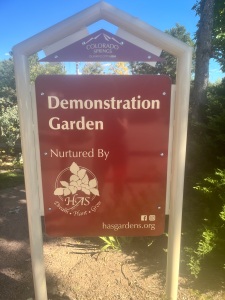

Founders’ Day Lecture by Mike Kintgen
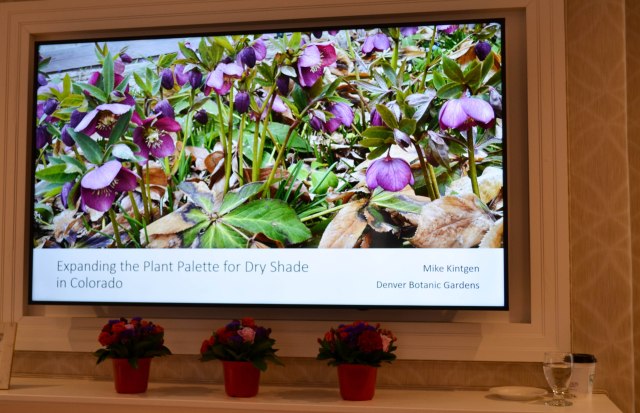


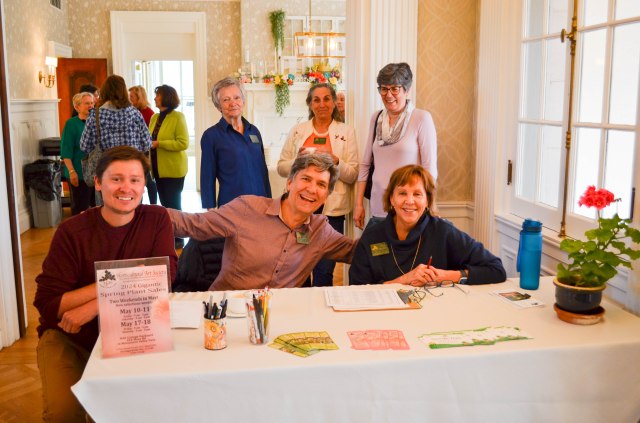



State of the Gardens – 2023 Year in Review
by Erin Eisen, HAS President
I struggle to accept the fact that 2023 is almost over — where did the year go? A rhetorical question, of course, as it was another busy HAS year filled with activities and adventures!
Our spring season kicked off with three great lectures by Alex Crochet (starting natives), Joan Nusbaum (soil), and Allisa Linfield (gardening in containers). April’s Founders’ Day brought Marcia Tatroe with a lecture on Western Cottage Gardens at the lovely and historical Peel House. Our Education/Events committee has already been busy booking the lectures for next year, so look for that information coming soon!
May, though the weather was still cold and wet, didn’t stop our volunteers from setting up and working this year’s Gigantic Spring Plant Sale. We had a great selection of plants this year, and had a very successful sale. In fact, our profits are close to the pre-Covid 2019 amount (which so far has been our highest grossing year). Many thanks to everyone who helped, particularly Pam Hamamoto!
After our Plant Sale, the race was on to start getting plants in the ground in the gardens before it got too hot. In some ways we were lucky that the weather stayed cool through June, giving most of the plants more time to get settled before the change in temperatures.
Can’t say that a lot of veggies appreciate the cool weather, though, but that’s gardening, isn’t it! Eva Regan, who took charge of our new vegetable garden this year, handled it all with grace, and we had a very successful growing season. In fact, we won an honorable mention for “Tidiest Garden” for our submission to the All-American Selections garden competition (we’ll take it)!
Barb Valenti took charge of our roses this year, and enlisted her husband to help build some trellises for those that needed reigning in. She organized a rose lecture with the Pikes Peak Rose Society, after which we went out and practiced on the roses at the Demo Garden. She continued to prune, fertilize and dead-head our roses through the growing season, and they looked better than they have in quite a while! We will be offering some more of these rose-pruning classes this spring — another reason to read the newsletter!
Louise Conner and Terry Webb kept our Demonstration and Heritage gardens maintained this year, and we appreciate the time that this requires. The gardens looked really nice this year, so thank you for your efforts. The gardens are a constant work in progress, but really good strides were made this year — from adding some decorative boulders and rethinking garden beds, to adding appropriate plantings (particularly more natives)! We also couldn’t have done it without the assistance of Golden Bee Gardens, who have done a lot of the garden tasks that our volunteers haven’t been able to accomplish and we thank them, also!
No doubt you are already familiar with the challenges that we had this year, particularly with our hoop house repair and the Lorelei statue. Right now we are in a good position with both of these items. The hoop house was recovered by Kirby Thompson and his son Britton (of Britton nursery), and then we hired Ted McCormick (who built our veg garden) to replace the North and South walls. Alex Crochet has offered to help build shelves and add temperature-moderating containers to make it a functional hoop house, used to extend the growing seasons.
The Lorelei, which had been vandalized in June, was restored by Pacific Coast Conservation, but not before consultation with a host of concerned parties. Though this was a bummer of a set-back, contacts were made (or renewed) that will probably continue in the future. We still need to apply a protective coating to the Lorelei, and then we can claim victory over this particular challenge.
We also took the time to show our appreciation to our volunteers at our Volunteer Appreciation/Plant Swap in August. This year we decided to host a British Tea (though the heat called for iced over hot tea)! We are so thankful for all our volunteers — our HAS Board, Board Support, Plant Sale volunteers and garden volunteers. You are all integral to the success of HAS and the gardens!
We are also thankful for some nice surprises that came our way this year, particularly by way of Colorado Springs Parks and Rec. We now have very nice new signs at the entrances of the Demonstration, Heritage AND Pinetum gardens.
We were also floored when we were informed that the cottage windows and doors (and locks) were going to be replaced. We had been going about our business at the cottage with boarded-up windows, so we were thrilled with this update. We also got new blinds for the windows! As if that wasn’t enough, we are also supposed to get the fence that borders the cottage and hoop house area replaced before the growing season. We can’t thank Parks and Rec enough for their investment and support!
All of this and more was covered at our Annual Meeting/Silent Auction this year. Even though we didn’t have a big turnout this year, everyone who attended had a great time and walked away with some great deals from the auction. We also welcomed and voted in our four new HAS Board members. I anticipate a great year ahead, full of more adventures — and we hope that you join us in the fun!
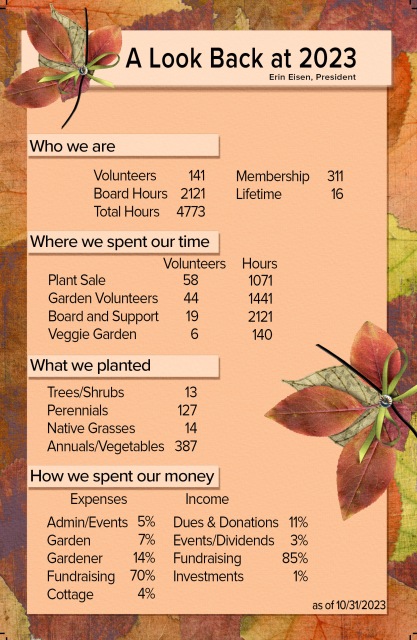
Our Volunteer of the YEAR is Pam Hamamoto!
Pam really IS the plant sale. Pam goes out of her way to visit each new vendor in person which means time on the road. She also works ALL the shifts at the Plant sale to insure that her selections get sold. She is the floor sales person extraordinare! She also helps out in the garden, at our events, and will be giving one of our lectures next year. Congratulations

The Henry Cannell Award is the award given to the person or persons who support and uplift the foundations of our organization.This year the award goes to Barb Valenti and her husband, Jim Mellon—our power couple of the year!
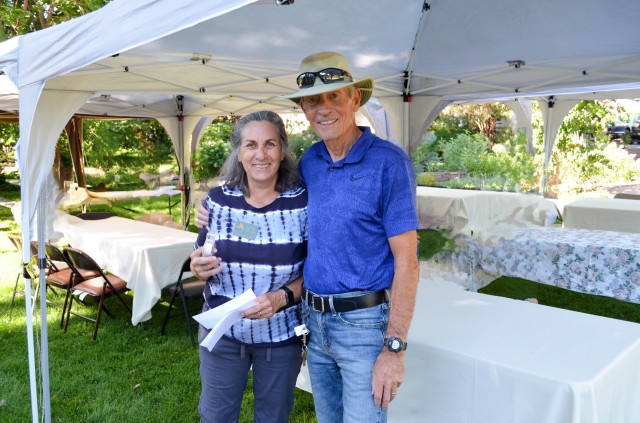
Barb really is a workhorse—she gets stuff done, and in such a timely manner (usually when the rest of us are still mulling things over in our minds. We started out this gardening season with very few volunteers, and Barb helped to bring those numbers up. Some of those volunteers are younger adults, and we are so excited to see this—we need to keep attracting the next generation of HAS members and volunteers. To honor those volunteers, she organized the Volunteer Appreciation Event, which was just lovely! She also organized our what will hopefully become our annual BOSS volunteer event. Barb also helped us re-establish our defunct relationship with Pikes Peak Rose Society, which she is a member of. This lead to an informative lecture and demonstration of rose-pruning in our gardens early this last spring.
Her husband, Jim, works just as hard! He built our rose trellises in the back and the front of the cottage. He has also re-worked our edging in the Pinetum and the Demonstration gardens, which takes a lot of work! He also attended our BOSS event, working alongside us mucking out our drainage areas. He, as you can see in the picture, helped with set-up and take-down at our volunteer appreciation. Well Barb, I know that there is more that I haven’t listed, but please know that everything that you and Jim do has been very much appreciated!

Deep Into the Weeds
by Rob Lucey, HAS Trustee
One of the most tedious tasks for all gardeners is controlling unwanted plants, also known as weeds. It can become a feat of endurance, an exercise for building various muscle groups, a plant identification brain teaser, or even a philosophical pursuit.
A weed or not a weed? That is the question. Any plant may be considered a weed if it’s growing in the wrong place. And, after this particularly wet spring in the Pikes Peak region, there are many, many plants growing where gardeners don’t want them. What to do?
In most cases, it’s a matter of rolling up your sleeves and yanking them out. And yanking them out. And yanking them out some more. Look at it as a meditative activity. Add some squatting and flinging, and you can even claim that it’s exercise. Who can’t use a bit more fitness?
If they are young with shallow roots, you might sometimes get away with hacking your weeds with a hoe. Sometimes that just stirs up more seeds or fails go get up roots and your weeds simply re-sprout.
If you’re pulling or hoeing weeds and they haven’t seeded yet, you can leave them on the ground or toss them under other plants to form a mulch (often referred to as the chop and drop method). Or you might collect them and put them in a good compost pile. A “good” pile is one that gets up to a high enough temperature to kill any unintended seeds that sneak into the pile. If your weeds have already gone to seed, your best bet is to carefully load them into a yard waste container.
Other times, people resort to chemical warfare. This may range from simple boiling or salty water or acidic vinegar/dish soap concoctions (all relatively benign, longterm), to an array of commercial herbicides with potential environmental and health risks. I won’t take a stand on this approach other than to recommend doing some research, especially if you’re growing food crops, want to keep pollinators and other wildlife healthy, or live where runoff from your garden might enter our water supply (which is nearly everywhere).
The main secret to controlling weeds is to eliminate them before they can bloom and shed another generation of seeds. It is said that some weeds (I’m looking at you mallow, lamb’s quarter and purslane) can shed enough seeds in a single season to germinate for another eight years or more. So, if they’ve bloomed, brace yourself for the long haul in weed management. Heavy mulch is also important to prevent seeds from falling on soil where they can take root.
What are some of the most common nemeses in local gardens? In random order, here are my dirty dozen.
• Elm seedlings. Some years, Siberian elm trees shedding seeds can look like snow falling. This is one of those years. Combined with moisture, each of those “elm flakes” can turn into a sprout that, eventually, becomes a new tree. Each elm tree has the potential to spawn entire forests. You’ll want to pull them up before that happens. Fortunately, time is on your side. Even a year-old elm is only a few inches tall and easy to yank. Wait a few years, however, and the roots might break off allowing the saplings to re-emerge. The cotyledon (or seed) leaves are round and easy to spot. Often seeds wash up together and entire clumps of seedlings erupt in tandem like a subterranean chia pet rising to the surface. Long-term fix? Fewer elm trees.
• Ash trees. Another prolific seed producer, ash trees drop long pointy seeds that can stick in the ground or blow into drifts. They also pop up during a moist spring with a pair of long cotyledon leaves atop a stem. The trick with them is that the seedlings can initially resemble other sprouts such as marigolds. If they’re popping up in your flower bed, it might be wise to wait for the first true leaves to verify identity. Again, they are easy to pull and not terribly fast growers.
• Spurge. This is a common scourge in sidewalk cracks and gravel driveways everywhere. We’re talking prostate spurge. Bitter, milky juice when you break the stem is the telltale identifier of these sprawling plants. Left unchallenged, they can form thick mats that choke out other plants. (Note – The related myrtle spurge is another nemesis for many. It can look like an attractive ornamental succulent, but it has a tendency to scatter seedlings up to 15 feet a year, until it gets out of control. That habit has earned it a “noxious weed” designation in Colorado.)
• Purslane. Often sprouting in the same places as spurge with a similar growth pattern, it is good to learn to distinguish the two. Purslane leaves are more succulent and the stems don’t have the telltale milky sap of spurges when broken. When you pull up purslane, you might want to consider throwing it atop your salad bowl or dropping it in your soup. Or pickling it. Or making some chimichurri. It is highly nutritious with a pleasant flavor. Do not, however, attempt cooking with spurge, which is toxic.
• Mallow. This relative of okra and hollyhocks can drop huge numbers of seeds. Mature plants feature deep taproots that are difficult to pull, so get them while they’re young. The spade shaped cotyledon leaves are fairly distinctive. If you have large quantities, use them as sprouts atop your salads. Mature leaves are also edible. Some people add them to soups or coat them in olive oil and bake them into chips. The round seed pods, flowers and roots are also edible. Eat your weeds!
• Lamb’s Quarter. Another edible that sheds abundant seeds, this plant is often found popping up in garden beds, fields and along roadsides and local trails. It’s a member of the amaranth family and the leaves are a pleasant spinach substitute. In some countries it’s grown as an agricultural crop.

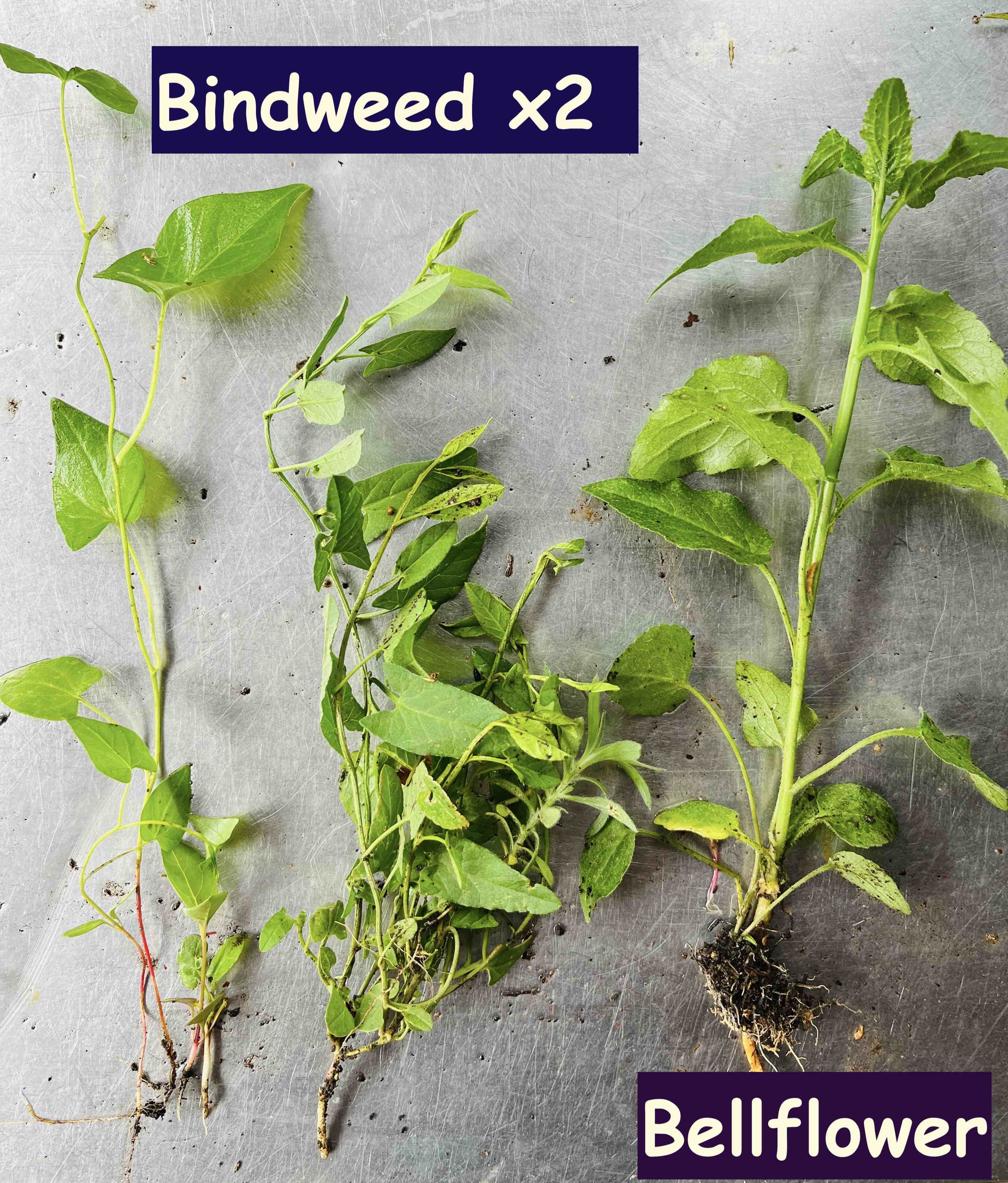
• Bindweed. This perennial weed can be sneaky. There are actually two types of bindweed, but both act similarly, climbing over and through everything in their attempt to takeover the world (or at least your garden beds). Bindweed tends to sprout under your garden plants’ leaves and can go unnoticed until it starts to wind around and climb the stems. If you spot the seedlings early with the spade-shaped leaves and red stems, they are easy to pull. However, once they start wrapping, it can require patience to untwist them if you want to avoid damaging your garden plants. Some people see the white or blue flowers of established bindweed vines and mistake them for related morning glories.If they’re that far along, you’ll need patience and shovels, extensive solarization, or chemistry to eradicate the roots and eliminate the nuisance.
• Creeping Bellflower (also known as Queen Palmer’s Revenge, harebell and less flattering other names). This perennial is the bane of many local gardeners, as it spreads in every manner (roots, seeds, teleportation). Older plants sport parsnip-like roots, making them a challenge to pull. Some people like the purple bellflowers, but if you cultivate them be prepared to give them the entire bed. And perhaps your lawn, driveway and all of your other beds as well. The leaves and roots are actually edible, but they have little flavor or nutritional benefit to recommend them. Persistently pulling off the plants eventually slows their spread. Digging them out (usually a few times) might eliminate them. But probably not, especially if your neighbors aren’t joining you on the battlefront.
• Dandelion. We all know about these little yellow spots of sunshine in the yard and the ensuing white seed puffs. Good for pollinators? Good for salads, wines or sautéed greens? Perhaps so. But they still want to take over the world if left to their own devices. Best to toss the seed heads into trash before they blow where you don’t want them.
• Kochia. Perhaps you’ve seen a soft carpet of olive green hairy plants along a roadside or under a tree. Or individual specimens in your gravel walkways or along the edges of your garden beds. Let those plants mature and you’ll have a pile of tumbleweeds ready to sprinkle their seeds across the countryside. Best to pull them young or chop them with the hoe.
• Quack grass. Mixed in your lawn, perennial quack grass isn’t too offensive. With its vertical growth pattern, it tends to be a bit taller than turf grasses, prompting you to have to mow more often. Otherwise, it mostly blends in. But who wants grass in their flower and vegetable beds? And that’s where quack grass is headed, sending long horizontal runners underneath any and all bed borders. If you have loose soil, it isn’t too onerous to pull it up. Pull with a slow, steady pressure and you’ll end up with a series of tufts joined on a long white runner. If the runners run under your garden plants or you have heavy, clay soil, they will probably break off and you’ll need to repeat the effort indefinitely.
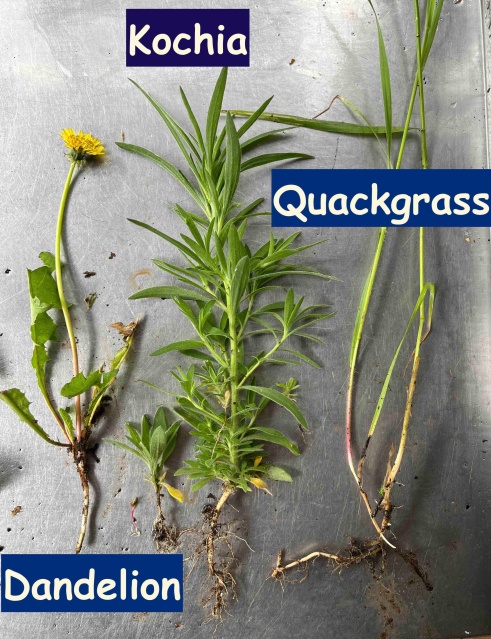
• Crab grass. This is the opposite of quack grass. It is an annual that has a more sprawling horizontal growth pattern above ground while sending fibrous roots straight down. They don’t usually appear until later in the summer. Dig it out before it seeds and maintain good mulch in your beds to keep seeds from sprouting.
